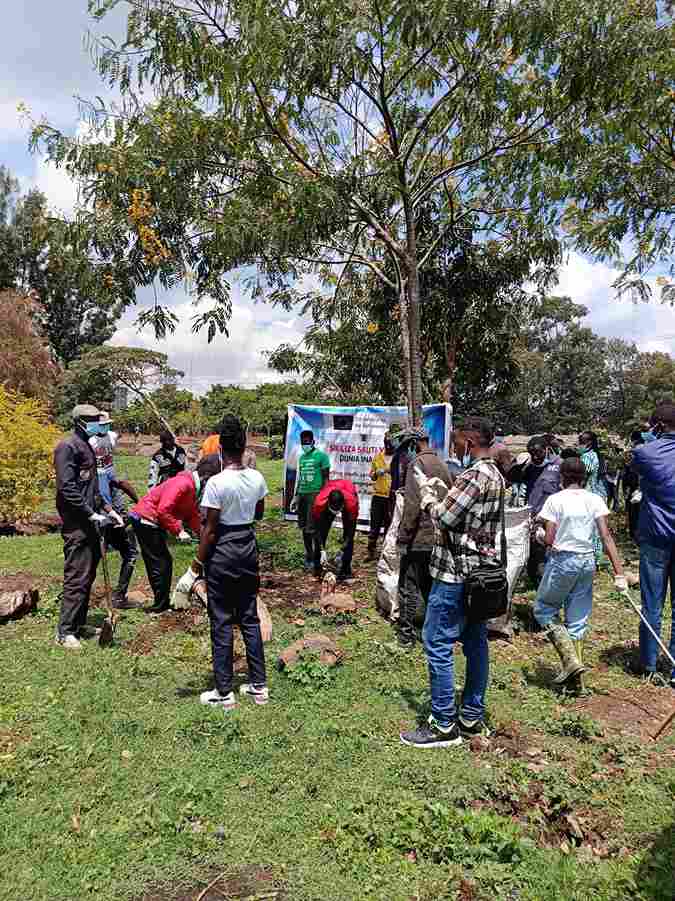+254797 813499

Posted by OAY Kenya on 01-Aug-2025
In Nairobi’s fast-growing neighbourhoods, waste is piling up faster than it’s being managed. Open spaces and once-green footpaths are now strewn with rotting trash.
Streets buzz with business activity right next to heaps of uncollected garbage.
It’s easy to walk past, complain silently, and move on. But for Janice and Samuel, two young environmental volunteers, ignoring the problem is not an option.
From July 20 to 27, the duo crisscrossed Nairobi’s estates and backroads, mapping waste dumping points as part of the Nairogreen Campaign, a youth-led digital initiative powered by the Organisation of African Youth-Kenya (OAY).
Their mission? To spotlight where the city is failing in waste management and mobilize solutions from the ground up.
This work sits within the broader Sikiliza Sauti Yetu (SSY) project, supported by WeWorld, which seeks to empower young people to lead climate action in their own communities.
And as they took photos, filmed videos, spoke to residents, and uploaded waste data to a live microsite, Janice and Samuel weren’t just tracking rubbish, they were building a blueprint for youth-led sustainability in urban spaces.
A Day in the Field
Every evening, Janice and Samuel agree on where to go next. At sunrise, they meet at a central point and dive into the day.
“Once we arrive in the area, we look for waste dumping sites—some legal, many illegal,” Samuel explained. “We talk to people nearby to understand the situation. Is the site sanctioned by the county? Has the waste been there for days or months? Is it ever collected?”
Their findings are uploaded to the Nairogreen digital microsite, which helps visualize the waste problem across Nairobi. The tool reveals where bins are missing, which sites are neglected, and where urgent intervention is needed.
But their work goes beyond the data.
The Reality on the Ground: A System in Crisis
During their one-week fieldwork, they visited several estates and streets in Nairobi, mostly in informal settlements and mixed-use neighbourhoods and a big part of the effort involved speaking and listening to the people.
According to Janice, the conversations are often mixed. “On a typical day, we interact with business owners and residents,” she said.
“Some are open and ready to share information. But others are defensive. One man we approached told us he wasn’t interested and brushed us off. He didn’t understand that we were here to help.”
Moreover, they observed that in these areas, the dumping of waste is often not a choice but a last resort.
“A lot of people dump waste because it’s convenient,” Janice shared. “There are no bins, so they find an open space and use it as a dumping site. Sometimes it’s because they have no choice. But also, in some places, even when bins are there, people still throw rubbish anywhere.”
This observation is part of a bigger problem. Nairobi’s waste management system is strained.
The county government struggles with timely waste collection, and bins are either missing, stolen, or damaged.
People have adapted to this failure, but not in the best way. “Some residents have just stopped caring,” Janice added. “Others don’t even understand the impact this has on their health or on the environment.”
Yet amid the dysfunction, their week on the ground offered insights, and hope.
What Needs to Change
Despite the resistance and setbacks, the two young mappers remain hopeful.
The week on the ground helped them better understand the bigger picture—and they have some ideas on what should be done.
1.Raise awareness in the community. People need to be taught about proper waste disposal. That education is missing.
2.Install more bins. There are places where people want to dispose of waste properly—but there’s nowhere to put it.
3.Ensure regular waste collection. It’s not just about having bins. If the county doesn’t come to pick the waste, it will still pile up
4.Motivate residents to take pride in their spaces. If people see their environment improving, they’ll feel the need to keep it that way.
The Role of Youth in Climate Action
At the centre of this campaign is one powerful truth: young people are not just beneficiaries—they are changemakers. Through the Sikiliza Sauti Yetu project, OAY is working with youth in certain counties to shape how climate action is done at the local level.
Young people are collecting data, leading community forums, engaging with leaders, and using digital tools like Nairogreen to push for accountability.
Under its Environment and Climate Change focus, OAY has invested in building young people’s skills in digital advocacy, storytelling, climate education, and environmental leadership.
The idea is to put tools in the hands of the youth, and trust them to lead the way.
Janice and Samuel are living proof that this approach is working.
All Roads Lead to the Summit
This August, their voices, and those of many other young environmental leaders—will converge at the Kenya National Youth Climate Action Innovation Summit in Nairobi.
The Summit, happening on August 7–8, is part of the Sikiliza Sauti Yetu movement. It will bring together youth, policymakers, innovators, and organizations to amplify local action and spotlight youth-led climate solutions across the country.
From mapping trash to rewriting the future, Janice and Samuel ’s story is just the beginning.
By Lynet Okumu
0 Comments